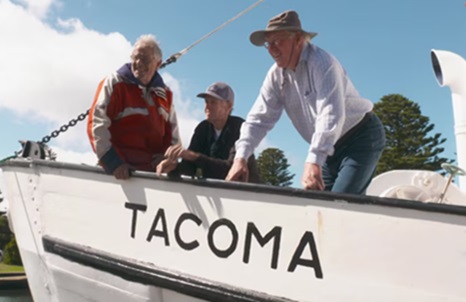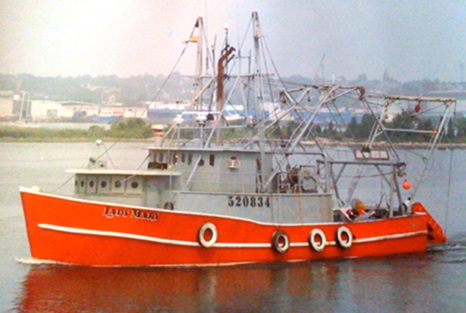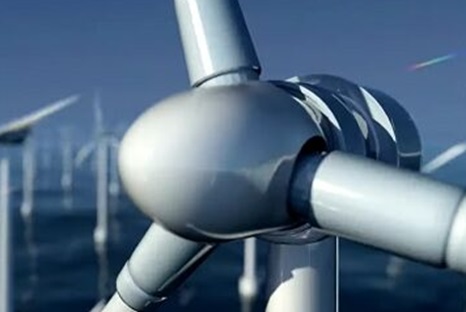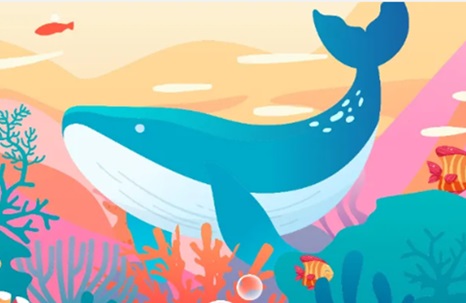Category Archives: Featured

It’s Been a Brutal Year for Offshore Wind — Despite Analysts’ Best Guesses
Since the start of 2023, approximately 60% of all contracts signed by American offshore wind developers have been cancelled, according to E&E News. Ørsted, a Danish company and one of the world’s leading offshore wind developers, backed out of two major planned projects in New Jersey in 2023, while other players like General Electric, British Petroleum (BP) and Equinor attempted to renegotiate with state governments as economic headwinds eroded projects’ profitability. Similar developments have played out to start 2024, with developers up and down the east coast backing out of deals to sell power from their projects as the same fundamental economic problems persist despite the projections of some market experts and media outlets. more, >>CLICK TO READ<< 08:57

Port Fairy residents reminiscence origins of 1950s pioneering fishing boat, Tacoma
When the grand old wooden fishing boat Tacoma returned home to Port Fairy, its skipper Ross Haldane was transported back 72 years. The 76-year-old grandfather was one of the seven children onboard when the boat left in the early 1950s destined for South Australia to bolster the state’s growing  fishing industry. “I remember the boat going into its first big waves — we quickly ran down into the galley and watched the waves from there,” Ross said. Ross and one of the original crew members, 90-year-old Jack Bellamy, made the return trip this year aboard the Tacoma from Port Lincoln to Port Fairy, where it arrived on March 25. Photos, Video, more, >>CLICK TO READ<< 06:30
fishing industry. “I remember the boat going into its first big waves — we quickly ran down into the galley and watched the waves from there,” Ross said. Ross and one of the original crew members, 90-year-old Jack Bellamy, made the return trip this year aboard the Tacoma from Port Lincoln to Port Fairy, where it arrived on March 25. Photos, Video, more, >>CLICK TO READ<< 06:30

Report portrays mixed picture of Alaska’s huge seafood industry
The report from the McKinley Research Group, titled The Economic Value of Alaska’s Seafood Industry, is the latest in a periodic series commissioned by the Alaska Seafood Marketing Institute. The total economic value of the Alaska seafood industry in 2021 and 2022 was $6 billion, slightly more than the $5.6 billion tallied in 2019, the last full year prior to the COVID-19 pandemic, according to the new report and the previous version published in 2022. Along with that good news, the McKinley Research Group’s report contains a warning about the industry’s economic future. The seafood industry, between harvesters, processors and managers, accounted for 48,000 jobs on average in 2021 and 2022, equivalent to 29,100 full-time positions, the report said. That is a reduction from the 62,200 total jobs in 2019, the equivalent of 37,400 full-time positions. more, >>CLICK TO READ<< 11:21

Fishing Vessel Lady Mary Remembered 15 Years After Sinking
On March 18, 2009, the F/V Lady Mary, a 71-foot scallop boat, left Cape May Harbor for the scalloping grounds in an area known as the Elephant’s Trunk, roughly 60 miles from Cape May. The crew had nearly completed its catch when, between 5:19 and 5:39 a.m. on March 24, the boat sank. Six of the seven crew members were lost. Over the next four years, the Coast Guard and the National Transportation Safety Board completed investigations into the sinking, concluding there were multiple factors responsible. The Coast Guard filed its report on Aug. 23, 2013, saying the Lady Mary did not capsize, nor did it sink due to a fire or explosion. Despite the reported nearby presence of a container vessel named the Cap Beatrice, the Coast Guard concluded there was no evidence that any other vessel was at fault for the chain of events that eventually led to the sinking. Photos, more, >>CLICK TO READ<< 07:35

Once Sourced Out-of-State, Shrimp From New York Is Becoming a Status Ingredient
When wild shrimp is US-harvested, it’s pulled in-season from the waters off Louisiana, Texas, Florida, and the Carolinas. Increasingly, though, a select number of New York restaurants are embracing local shrimp, highlighting fisheries in and around Montauk. Long Island’s royal red shrimp is caught off Montauk at nearly 3,000 feet. “Their color is a gorgeous, gorgeous dark red; a color I’ve never seen in my life,” says lifelong fisherman, K.C. Boyle. Photos, more, >>CLICK TO READ<< 06:42

This injured N.L. fisherman paid a heavy price protesting for free enterprise
It takes some effort and plenty of discomfort and anxiousness for Richard Martin to lift himself off his couch, settle in behind his walker, and make his way around his house. It was just after 8 a.m. on Wednesday, March 20, and Martin was one of hundreds of frustrated seafood harvesters — many of whom had travelled long distances — who were blockading Confederation Building in St. John’s, preventing public service workers and politicians from accessing the sprawling complex. With Port de Grave fisherman John Efford Jr. leading the charge, they were there fighting for what they were calling “free enterprise,” or the right to have more say over how they catch, land and sell their seafood. Video, Photos, more, >>CLICK TO READ<< 08:10

A vessel capsized off Newfoundland’s west coast
A rescue operation is underway Sunday near Port aux Port, between Molly Ann Cove and Rope Cove (Submitted by Sam Anderson) A vessel on the west coast of Newfoundland was found capsized on Sunday morning near Port aux Port. Fish harvester Sam Anderson was fishing in the area around Molly Ann Cove and Rope Cove around 11 o’clock Sunday morning when he spotted a cabin on fire on shore. There, he saw a couple of men on the beach, he said, with a capsized vessel nearby. “We followed the procedure, you know, contacted the Coast Guard radio and we tried to get him. We couldn’t get at him because the waters were too shallow and nothing we could do,” Photos, more, >>CLICK TO READ<< 14:29

3 New York wind farms scrapped – Cost implications for Mass., Conn., and R.I.
New York pulled the plug Friday on three offshore wind projects that encountered pricing problems after GE canceled the development of a larger turbine that the developers had been counting on. The decision is a setback for the US offshore wind industry and may have some cost implications for Massachusetts, Connecticut, and Rhode Island, which are in the midst of a joint procurement for offshore wind power. The three wind farms proposed for the coast off New York were all tied to a plan by GE Vernova to start producing giant 18-megawatt turbines at a facility on the Hudson River to be subsidized by the state. more, >>CLICK TO READ<< 10:04

The Day Lake Superior Gave Up Her Dead
The Jones family of Cornucopia, Wisconsin, was well known as both boatbuilders and commercial fishermen on Lake Superior. Thomas Senior and his two sons, Thomas Jr. “Coonie” and Emery, made good money in the fall of 1924 when the price of herring was unusually high.The price of trout was also high at the time, and the men knew they could make even better money if only they could fish trout on the Big Lake after herring season  closed. Overwinter fishing on the open Lake had never been done out of the small harbors of the South Shore. Another problem was, the Joneses didn’t have a proper boat capable of staying out beyond the pack ice for any length of time. Enter the Thomas Friant, a 96-by-18-foot abeam, 81-ton wooden hulled ferry built in Grand Haven, Michigan, in 1884. The passenger-hauling Friant had been converted to a massive – for that era – fishing tug. photos, more, >>CLICK TO READ<< 09:06
closed. Overwinter fishing on the open Lake had never been done out of the small harbors of the South Shore. Another problem was, the Joneses didn’t have a proper boat capable of staying out beyond the pack ice for any length of time. Enter the Thomas Friant, a 96-by-18-foot abeam, 81-ton wooden hulled ferry built in Grand Haven, Michigan, in 1884. The passenger-hauling Friant had been converted to a massive – for that era – fishing tug. photos, more, >>CLICK TO READ<< 09:06

A good plan or not? Dual-Purpose docks stir waters with local shrimpers
On the shores of San Carlos Island, just off Shrimp Boat Lane, the docks of the former Trico Shrimp Company look unchanged since Hurricane Ian. That’s soon to change since, on Tuesday, Lee County Commissioners voted to direct staff to budget for a new dual-purpose dock design for the waterfront land. For over seven years, Mathew Shetters has captained a shrimp boat for Trico. The proposed redesign might allow the county to use the docks to keep large barges for disaster response – disrupting regular operations. Video, Photos, more, >>CLICK TO READ<< 10:14

More things to worry about by Jerry Leeman
Wind energy in the Gulf of Maine is going to be a great challenge to all varieties of commercial and recreational fisheries. What disturbs me the most is, in all my travels along the coast in the four major fishing ports in New England, very few commercial fishing Captains were aware of the new talks on changing the management stock areas and the reallocation of codfish. This is a concern for many now that they are aware. This raises the question, if no Captain’s that fish inside the Wind Energy proposed areas were not aware of this future action, then how can the last comment periods on the proposed sights be accurately sighted? Charts graphs, more, >>click to read<< 13:16

FFAW applauds new deal on crab pricing, but says system still needs fixing
Harvesters refused to fish for more than a week, until the FFAW and Association of Seafood Producers reached a deal on Sunday that included increases to minimum prices and a settlement at the end of the season. That deal will override the panel’s decision. The deal struck Sunday includes a floor price of $3 per pound for the entire 2024 season. Both sides will be able to file for a reconsideration if the market price goes above $6.50 US. Harvester Glen Winslow was getting ready to finally start his season Monday morning in St. John’s. He said it’ll likely be a few days before boats head for the crab grounds. “I’m quite satisfied with where we got, to be honest with you,” Winslow told Radio-Canada. Photos, more, >>click to read<< 06:11

Pioneering decarbonisation
Following his initial experience of the Pilothy project, a feasibility study into converting trawler Anita Conti to run on hydrogen, Loctudy trawler operator Julien Le Brun went back to naval architect Coprexma for another decarbonisation project. The 17.50-metre trawler L’Amour de la mer (ex-Magali) is to serve as a technological platform to test hybrid electric propulsion and equipment systems. The Startijenn Up project aims to demonstrate the effectiveness of existing decarbonisation options that can be integrated on board. The vessel will be outfitted with two Caterpillar generators, providing power to the electric propulsion motor, the electric winch motors and for on-board consumption. Depending on the requirement, consumption will be optimised by running on one or both groups. 100% electric mode can be used for part of the operations. more, >>click to read<< 09:20

Fishery council seeks more information before deciding on chum bycatch in Bering Sea pollock fishery
The North Pacific Fishery Management Council, which manages federal fisheries in Alaska, will continue to explore options for how to manage chum salmon bycatch in the Bering Sea pollock fishery. The council, facing rising pressure from western Alaska communities who depend on chum as a cornerstone of subsistence, released a statement Wednesday summarizing their decision from their April meeting. Dismal western Alaska salmon returns have reached crisis levels. And while the council listened to scores of harrowing testimonies recalling empty rivers and vacant fish camps, the council was also presented with research that suggested bycatch limits wouldn’t do much to help the crisis. “Available science indicates recent declines in chum salmon populations across many regions of the North Pacific, including Canada, Japan, Russia, Korea, and the U.S., appear to be driven by warmer water temperatures in both the marine and freshwater environments,” the council said in the statement. more, >>click to read<< 12:38

Versatile Inshore Boat for the Basque Country Fleet
Although the general trend in the fishing sector in the Basque Country and the rest of Spain is to export or decommission, some owners from the town of Arminza, in the province of Vizcaya (north of Bilbao), decided to build a new vessel. Made of GRP, Beti Itsasoko has a 14-metre length and a beam of 5 metres, it has a number of features that set it apart from the boats with which it shares its fishing grounds. To begin with, it has an unusual modern design for Spanish waters, with an inverted bow, designed for more comfortable operation by minimising pounding as it cuts through the waves. On the other hand, the vessel measures 14,7gt and is configured to have two independent engines, which gives it greater maneuverability as each drives its own shaft, propellers and rudder. It also has a capacity for 8000 litres of fuel and a hold with space for almost 9 tonnes of fish in the chilled fishroom. Photos, more, >>click ti Read<< 16:66

OFFSHORE WIND AND WHALES – A collection of articles from fisherynation.com By Jim Lovgren
After over forty-five years as a commercial fisherman out of Point Pleasant NJ, I sold my boat the Shadowfax, and retired, moving to California. My experience as a fisherman began in the early 1970’s, and I observed and learned an encyclopedia of knowledge concerning fishing, the environment, and fishery management, including politics. As I observed the continuing massacre and the lies denying them by government and media puppets, I under took an effort to expose the truth concerning offshore wind. The following articles are listed in order of their appearance in Fisherynation.com, and are best understood by reading them in order. Just click on the title of an article you’d like to read. more, >>click to read<< 15:09

Crew School provides a reality sea trial for commercial fishing wanabees
Along Gig Harbor’s waterfront, this vocational trend is gently materializing in the form of a newly organized Crew School for potential commercial fishermen — and women. During March, seven people completed this hands-on training program that essentially offers a reality-based test drive for those interested in commercial fishing aboard a 58-foot purse seiner. Lifelong local fisherman and purse seine captain Gregg Lovrovich is program lead and creator of the crew-in-training curriculum. He coaches rookies through knot skills, gear maintenance, net setting/handling, safety and survival skills, not to mention the realities of living for months in a 58-foot space with 3-4 crew members who get all too familiar with one another. Photos, more, >>click to read<< 13:04

New Design Scalloper offers Economic Operation
Although the original brief had been for a sister vessel to Eternal Light, which has been fishing successfully since its delivery in 2019 to Fraserburgh company Whitelink Seafoods, the choice went to a new design scalloper that would provide more deck and gear space, better crew conditions and greater economy. The new design, developed with Macduff Ship Design to incorporate a more efficient hull form and a new stern gear package designed to improve fuel efficiency. The 19.98-metre Eternal Promise has a beam of 7.40 metres and a fishroom capable of holding 33 tonnes of bagged scallops. This is an addition to Whitelink’s growing fleet and is designed to operate year-round in UK waters. Photos, more, >>click to read<< 09:03

Coastal Georgia Shrimping: A new season of uncertainty, possibilities and hope
In a word, “difficult,” said Dee Kicklighter of their most recent shrimping season. Kicklighter, who has worked with Mathews for about eight years, has seen first-hand how the unpredictability of the business can be costly. “You plan for something to be one price, and then the next week you come back, and it could be potentially thousands of dollars more, depending on what you’re dealing with,” he said of fluctuating prices, including fuel. Over the years, Mathews said the ever-changing cost of fuel has taken a toll on the number of shrimpers in the industry. It’s not just Georgia shrimpers contending with the negative effects from imports. North Carolina, Texas, Louisiana, Florida and other coastal states are also feeling the friction of narrowing profit margins that threaten their way of life. Photos, more, >>click to read<< 09:15

Alaska fishermen and processing plants are in limbo as a state-backed seafood company teeters
The fishing fleet in the Southwest Alaska town of King Cove would have been harvesting Pacific cod this winter. But they couldn’t: Skippers had nowhere to sell their catch. The enormous plant that usually buys and processes their fish never opened for the winter season. The company that runs the plant, Peter Pan Seafoods, is facing six-figure legal claims from fishermen who say they haven’t been paid for catches they delivered months ago. King Cove’s city administrator says the company is behind on its utility payments. And now, residents fear the plant may stay closed through the summer salmon season, which would leave the village with just half of the revenue that normally funds its yearly budget. “We should be fishing right now,” said Ken Mack, a longtime King Cove fisherman. more, >>click to read<< 09:36

New Beamer Hits The Water
A year on from the launch of Interfish beam trawler Admiral Gordon at Parkol Marine Engineering’s facility in Middlesbrough, the yard has launched sister vessel Admiral Blake PH-440 for the same customer. The yard’s newbuild no 60, Admiral Blake was wheeled out of the fabrication shed and craned into the Tees. Sister vessel Admiral Gordon was delivered last year and was the first beam trawler over 20 metres in length to be delivered by a UK yard for more than thirty years. Photos, more, >>click to read<< 10:23

Exhibition celebrates town’s lifeboat heritage
A new exhibition celebrates the “very intrinsic part” a lifeboat station has played in the history of a town in the west of the island. The display at the Leece Museum in Peel features images of key figures over the years, the lifeboats that have served the station, and stories of rescues carried out. Tony Quirk of Peel Heritage Trust said the town, which was “known for its fishing industry over the years” was “never short of fishermen and sailors willing to go to sea and rescue the stricken boats”. The exhibition has been designed to coincide with the 200th anniversary of the RNLI. Photos, more, >>click to read<< 09:40

Nantucket’s Commercial Scalloping Harvest Tops 8,000 Bushels
Nantucket’s commercial scalloping season comes to an end today, and the harvest by island fishermen will top 8,000 bushels for the first time since the 2019-20 season. Scallopers, along with officials from the Nantucket Shellfish Association and the town’s Natural Resources Department, all said they were pleased to see the final number above 8,000 bushels, a small but not insignificant increase over last season’s total of 7,329 bushels. Bruce Cowan was among the few scallopers still fishing on Thursday, and he returned to Old South Wharf with his five-bushel limit and a smile on his face just before noon. Even with heavy rain and wind gusts expected to top 40 mph today, he said he was still thinking about getting out there for the final day of the season. Photos, more, >>click to read<< 07:45

‘I’m not going to hang around:’ Some Maine lobstermen decide to quit over new regulations
Some lobstermen have decided the paperwork, and more harsh future regulations, aren’t worth it. Bill Coppersmith’s lobster boat is named the “Billy and Andy.” He stopped lobstering the day new reporting requirements started. “Forty-three years of doing it, I took the last of my gear out of the water on New Year’s Day. And I said, ‘That’s probably it,'” Coppersmith said. “It’s come to be too restrictive to go. It creates more work. And I can’t create any more revenue because of the restrictions they’re putting on here.” Lobstermen are also now required to keep a tracking device on board so the Atlantic States Commission can track their movements in the Gulf of Maine. Coppersmith says that’s an invasion of privacy. Video, more, >>click to read<< 06:26

Graves and Peltola Urge Biden to Immediately Halt Unsafe Shrimp Imports
U.S. Congressman Garret Graves (South Louisiana) and Congresswoman Mary Sattler Peltola (Alaska) sent a letter to President Biden urging him to immediately halt shrimp imports into the United States from India, following concerning reports of severe food and safety issues and labor violations in Indian shrimp processing facilities. The reports highlight that shrimp imported from India are farmed and they regularly do not meet domestic health standards; the suppliers themselves know this to be true, evidenced by their tactics to evade detection at American ports. Graves and Peltola noted that there is already high-quality, healthy shrimp caught in America that is being pushed out of the market by foreign shrimp sold at artificially low prices and unsafe for consumption. more, >>click to read<< 12:49

Massachusetts fishermen say feds are hypocritical in Gulf of Maine wind energy designation
A move to designate two million acres in the Gulf of Maine as a hub for wind energy is snagging a sharp hook from Massachusetts fishermen who say the development overlooks risks to the North Atlantic right whale. A handful of Bay State fishermen advocacy groups are teaming with counterparts from across New England in criticizing the Biden administration’s plans to industrialize the area off the coasts of Massachusetts, New Hampshire and Maine. Fishermen, however, say the industrialization of the two-million-acre area is “flatly inconsistent with a policy of endangered species protection.” “Fishermen are disheartened that the WEA designation favors foreign energy developers over marine mammal protection,” the Gulf of Maine Fishing Associations said in a statement last week. “This preferential treatment is in stark contrast to the federal government’s aggressive campaign to burden commercial fishing needlessly with crushing restrictions to protect whales.” more, >>click to read<< 08:43


















































